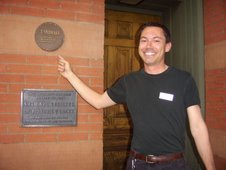
Nothing much has inspired me historically speaking the past weeks but the changing of hands of the Fontius block, you know,
Block 162, got me thinking again. Westword ran a great article on this very subject (
Warner, Joel. "Evan Almighty," Westword, September 13, 2007) and discussed the Steel Building AKA Fontius, as well as the lesser-known Orpheum Theater space which once stood on the parking lot to the rear of Fontius at 1513 Welton.
For years, this block at 16th and Welton has been dominated by the nearly empty
Fontius Building. Prior to Fontius moving to the Steel Building (1923), as it is officially known, the store was located in the
Symes Building (1906) at
834 16th Street. It sure is interesting to see a different Fontius sign after having the current 1960s version ingrained in our heads for so many years. But the Orpheum space has been off of the radar screen since being closed September 10, 1967. Subsequently demolished, along with the Tabor Grand in 1965, there were only three theaters left downtown by 1970: the Denver on 16th and Glenarm, the
Denham at 18th and California, and the Paramount. Today, only one survives!

This picture, circa 1933, shows the Denver Theater, where the Denver Pavilions stands today. If you look closely, you can see a different Fontius shoe sign in the distance at Welton. Notice the Kittredge Building and Paramount Theater on the right and the D & F Tower in the distance.
Finding information on the Orpheum Theater has come from a number of places. (See Forrest, Kenton and William C. Jones.
Denver: A Pictorial History, Boulder: Pruett Publishing Co., 1973.) In addition, online sources, if to be believed, indicate that the original Orpheum on Welton Street opened on October 5, 1903. It enjoyed life as a vaudeville show house, a silent movie theater and finally showed regular movies along with its numerous competitors downtown. Its multi-purpose stage hosted many acts, including those of Will Rogers, the Marx Brothers and Al Jolson.

This photo, circa 1910, shows the changing character of this once residential neighborhood. The old homes facing the Orpheum on Welton Street were not long for the world.


These two photos, circa 1920, show the unique architecture of the Orpheum. The top photo shows the future site of the Fontius Building, which was not constructed until 1923. The photo shows its predecessor, which I believe was known as the El Paso Building. The lower photo shows the Denver Dry Goods Company in the background. In addition, the Colonial/Republic Hotel is seen in the far left of the photo. This building is currently being razed.



The interior of the Orpheum was no less grand, as indicated by the photos above.
However, progress was marked by the reaffiliation of the theater around 1930 when it became part of RKO International. A remodel was in the works.


A new and improved Art Deco Orpheum greeted visitors in the top photo, circa 1930 (it is unknown what or who is being "hung" in the photo). The Orpheum was still packing people in for shows featuring Fred Astaire in the lower photo, circa 1950. However, competition from an increasingly suburbanizing public would soon spell doom to the downtown theaters, including the Orpheum. Television and drive-ins also hurt downtown movie business.

Out with the old, in with the new. This picture says it all. The First National Bank of Denver (621 17th Street) rises into the sky as one of Denver's earliest skyscrapers in this photo circa 1957. This building would become familiar to people around the world in the 1980s show Dynasty. It was one of the buildings shown in the opening credits to that show. Off to the side in this picture, the Orpheum awaits its fate, brought down by progress a decade later.
It's miraculous that the rest of Block 162 has remained intact up to this point. But now with the redevlopment of the block underway, only the McClintock and the Steel Building will remain. I think we should at least let the Fontius name remain. The Orpheum, Standish and Republic Hotel names will continue to fade away. However, the Steel/Fontius building will be made shiny again. Hopefully, the Fontius name will stick around and not soon be forgotten.
All historic photos are from the
Denver Public Library's Western History Collection. Some of the hyperlinks above direct you to
DenverInfill.com to view present day photos and maps of Downtown Denver.


















































